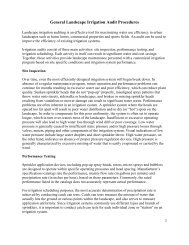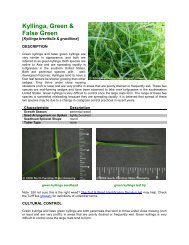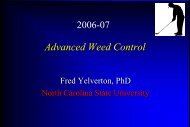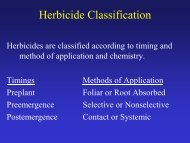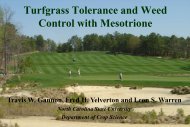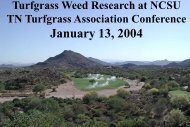Carolina Athletic Fields: - TurfFiles - North Carolina State University
Carolina Athletic Fields: - TurfFiles - North Carolina State University
Carolina Athletic Fields: - TurfFiles - North Carolina State University
- No tags were found...
You also want an ePaper? Increase the reach of your titles
YUMPU automatically turns print PDFs into web optimized ePapers that Google loves.
<strong>Carolina</strong> <strong>Athletic</strong> <strong>Fields</strong>: A Guide to Maintaining Quality Turf on <strong>Athletic</strong> <strong>Fields</strong>Installation of turfgrass sod on football field.prepared whether you are planting a new field or replantingan old one, and whether you are seeding or propagatingvegetatively. The following steps provide a generalguideline for preparing an area for planting a sports field.1. Clean and Rough Grade. Remove all constructiondebris, brush, large roots, rocks, weeds, and oldtree stumps. If extensive grading is needed, removethe topsoil and stockpile it for replacement afterthe rough grade is established. The site should becrowned 1 to 2 percent (½- to 1-foot fall per 50 feet)toward the sidelines. The rough grade should conformto the final grade after the topsoil is replaced.Poorly-drained soil may require the installation ofdrainage lines. Install them in a trench with at least a1 percent fall for drainage. Seek professional adviceif uncertain about the type and installation procedure.Perennial weeds should be controlled duringsite preparation. Several applications of a nonselectiveherbicide such as glyphosate (Roundup Pro) plusfluazifop (Fusilade II) may be necessary for completeweed control. Hard-to-control weeds may require theservices of a professional.2. Soil Analysis. A soil analysis should be taken beforeplanting. A representative soil sample can be submittedto NCDA Soil Testing service or to a private lab.A soil test will determine the pH value, and the reportwill indicate whether pH adjustment is necessary. Thedesired range of soil pH for bermudagrass is 6.0 to6.5. Values below 5.0 and above 7.0 can restrict rootingand specific nutrient availability. If the soil is tooacidic (pH too low), dolomitic limestone (dolomite)is recommended for increasing soil pH. Applicationshould be based on a lime requirement that considersboth soil buffering capacity and soil pH value. Inlieu of a lime requirement analysis, the applicationof 1 ton of dolomite per acre or 50 pounds per 1,000Clay areas of baseball fields require proper grading in relationto the turfgrass surfaces.square feet is sufficient to increase the pH of mostsandy soils one pH unit—for example, from pH 5.0to 6.0. For clay soils, 100 pounds per 1,000 square feetmay be necessary. Turf grown on alkaline soils (pHlevels greater than 7.0) often displays deficiencies inminor nutrients such as iron and manganese. Furtherdetails on soil pH adjustment can be obtained fromthe Cooperative Extension Service in your county.Based on soil test analysis, fertilizer should be appliedto correct nutrient level deficiencies in the soil.If phosphorus is deficient, a fertilizer high in phosphorus(such as 0–20–0) should be added prior toplanting. Potassium also should be added, if needed,prior to planting. A starter fertilizer (fertilizer withhigher P content than the other nutrients) shouldbe used at the time of establishment with vegetativeplantings, but delayed until after germination if thearea is seeded. Apply a fertilizer based primarily onsoil test results and local product availability. A generalrecommendation is to use a turf-type fertilizer in4:1:2 or 3:1:2 ratios with micronutrients. Apply at arate of 1 pound soluble nitrogen per 1,000 square feet.3. Installation of Irrigation Equipment. The irrigationsystem should be designed by an irrigation specialistand installed according to design specifications. Apoorly designed or improperly installed system willnever operate satisfactorily. Operation must be in amanner consistent with sound principles of turfgrassculture.Clay soilsFor heavy clay soils, sand can be added to improve physicalproperties. However, enormous amounts are typicallynecessary for a positive response. Typically, in a piedmontclay soil, up to 90 percent sand is required to make6




